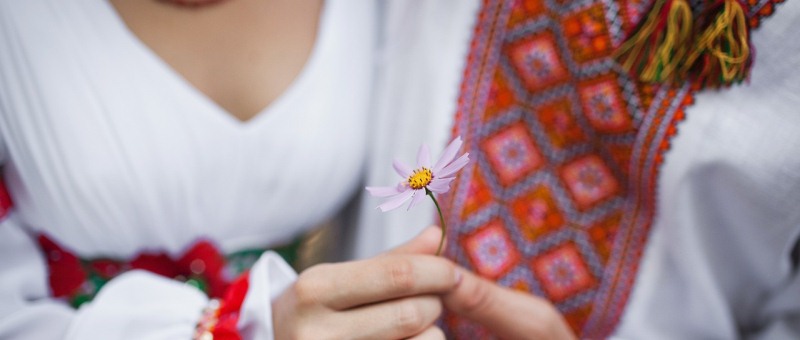What are Ukrainian Wyschywanka costumes?
The Wyschywanka, also spelled Vyshywanka, is a traditionally embroidered Ukrainian shirt. Every region of Ukraine has a unique embroidery pattern. Wyschywankas symbolize regional identity.
According to an old tradition, Wyschywankas serve as a declaration of love during the search for a partner in Ukraine. Young women in Ukraine embroider shirts for the groom as a sign of loyalty and love. Men and women from Ukraine celebrate Wyschywanka Day on the third Thursday of May.
More Dating Tips
- Attachment Style – Why Am I Not Succeeding in Love?
- Why Do I Always Dating the Wrong Person?
- Tips for dating 50 plus
- Dating over 50 on the Internet
- Dating Ukraine: Tips for Singles
- Why is she pulling away?
- Slavic Girls: the Meaning Behind Dating Theme
- Online Dating: How to Recognize Cold Fading, Ghosting
- Tips for creating a attractive dating profile
The History of Ukrainian Wyschywanka
Ukrainian Wyschywanka is much more than just a piece of clothing. In Ukrainian culture, it was also considered a symbol of loyalty. According to ancient traditions, Wyschywanka is a declaration of love from a Ukrainian bride to the groom. Traditions of the art of embroidery were passed down from grandmother to mother. If a woman in Ukraine was ready for courtship, she should be skilled in the art of embroidery. As a sign of loyalty, the young woman embroiders a shirt with her own hands. After marriage, only the beloved wife was allowed to wash the husband’s embroidered shirt.
Ukrainian culture has a rich cultural heritage. Each main region of Ukraine has its own unique tradition expressed in traditional costumes. The embroidered shirts indicate from which region someone comes. The embroidery patterns on traditional clothing can indicate the region, social status, and marital status of a person.
But these ornaments are also found in craftsmanship, furniture, shoes, hairstyles, and jewelry. Ukrainian costumes and traditional attire have evolved over generations due to historical, social, and cultural influences. Traditional Ukrainian embroidery has served as a source of inspiration for many international luxury brands such as Jean-Paul Gaultier, Dolce & Gabbana, Gucci, and others.
What does Wyschywanka mean?
Wyschywanka, also written as Vyshyvankas, is the term for traditional embroidered Ukrainian shirts and blouses. In modern times, it is common for every Ukrainian, from toddlers to the elderly, to possess at least one embroidered shirt and wear it on specific festive occasions. Popular days for men and women in Ukraine to wear embroidered shirts include Christmas, Orthodox Easter, Independence Day (August 24), and, of course, Wyschywanka Day (third Thursday in May).
Wyschywanka Day in Ukraine
The annual Wyschywanka Day falls on the third Thursday in May. Enthusiastic men and women in Ukraine wear embroidered shirts and blouses to work, school, and university. On the streets, lovely Ukrainian women dance in embroidered blouses, showcasing Ukrainian folklore. In some cities of Ukraine, Wyschywanka parades are organized.
The Ukrainian diaspora abroad also celebrates Wyschywanka Day. Ukrainians gather in larger cities in Germany as well. Women and men wear embroidered shirts, dance, and celebrate.
Fall in love on GenerationLove!
Meet other Singles and find new love on the GenerationLove dating platform!
Wyschywanka During the Soviet Union Era
Traditional embroidered clothing is an expression of belonging to the Ukrainian nation. During the times of the Soviet Union, the communist rulers in the Kremlin disrupted patriotic love for the homeland. People hid their traditional Ukrainian clothing. After the end of Soviet rule, Wyschywanka experienced a revival. Embroidered shirts became a symbol of personal identity and freedom.
After the Maidan protests in 2013, national symbols in the form of traditional embroidery patterns on dresses and shirts experienced a renaissance in Ukraine. Traditional embroidery patterns became a trend in Ukrainian fashion for both women and men. A trend that was further intensified by the war in Ukraine.
Ukrainian Wyschywanka: from Generation to Generation
The Ukrainian tradition of embroidery has been passed down from generation to generation. A mother embroidered for her children, a wife for her husband, and a girl in Ukraine for her boyfriend. Songs and prayers were sung during the work. It was believed that the shirt, made with love and faith, would protect its owner from all evils. Each region developed its own style of embroidery with predominant colors and patterns, each carrying a sacred meaning. Over centuries, Vyshyvanka has established itself as an essential element of local culture and a part of Ukrainian identity.
After the end of Soviet rule, Wyschywanka experienced a revival. Embroidered shirts became a symbol of personal identity and freedom.
Wyschywanka in Northern Ukraine
Wyschywankas in the North of Ukraine are characterized by an intense use of the color red. Here, plant ornaments are predominant, especially symbols of trees and fruits such as red viburnum and oak branches. It was believed that such intricately embroidered shirts helped in making the right decisions, imparting life energy, and gaining wisdom.
The Wyschywankas from the Kyiv region are characterized by contrasting patterns. The white canvas is adorned with vibrant colors, including red and black, featuring openwork grids used for both women’s and men’s shirts. Over time, floral ornaments gained increasing popularity, and even embroidered men’s shirts took on the character of imposing chest decorations. In the Ivankiv area, talented Ukrainian women developed an interesting technique: the pattern is first drawn on canvas, then outlined with black threads, and subsequently embroidered with other colors.
In the Chernihiv region, shirts were embroidered with tiny stitches, giving this embroidered clothing a unique appearance. The pattern consists of white threads with colored elements, presenting a floral or abstract appearance. Traditionally, shirts were also adorned with glass beads by women in Ukraine.
Geometric figures were most commonly represented in the Zhytomyr region, including crosses, diamonds, circles, zigzag patterns, and especially rosettes. These figures had a profound symbolic meaning and were intended to protect the wearer from negative influences. Women in Ukraine were particularly skilled at incorporating popular flower and plant ornaments such as evergreen, birch, hops, grapes, apples, and leaves into their embroideries.
Wyschywanka in the south of Ukraine
In the South of Ukraine, the landscapes with endless steppes and golden wheat fields are reflected in the ornaments of Wyschywankas.
In the Kherson region, the symbol of the “World Tree” was one of the most popular ideograms, symbolizing the connection with Mother Earth. Frequently, symbolic representations of animals such as the cuckoo, rooster, horse, and deer were also incorporated into Wyschywankas. The ancient Wyschywankas from Kherson were often embroidered with black threads, but white threads also found favor among Ukrainian women.
In the Odesa region, shirts were made of white cotton. The standing collar was ribbed, and the edges were finished with sizing. The upper sleeve edges were ribbed, and the lower ones were decorated with stitch knots. Red, black, blue, and yellow were the predominant colors that the women from Odessa skillfully incorporated into their embroideries.
The ladies’ vyshyvankas in Mykolayiv had a distinctive design with a square neckline around the neck and loose sleeves without frills at the wrists. Plant motifs such as fir trees, oak leaves, bumps, various flowers, and blooming branches were particularly popular among the women in Mykolayiv. Interestingly, the line was not only used as a separating element between embroideries but also interpreted as a symbol of good and evil. Similarly, zoomorphic patterns were very popular among Ukrainian women.
The embroidery patterns on traditional clothing can reveal the region a person comes from, their social status, and marital status..
Vyshyvanka in Eastern Ukraine
In the eastern part of Ukraine, the vyshyvankas are strongly influenced by Poltava embroidery, where the combination of red and black plays a dominant role in the embroideries. These colors hold symbolic meanings for Slavic peoples: Black represents sorrow, separation, death, and the afterlife, while red symbolizes love, joy, the ongoing existence of humanity, and kinship.
The shirts in the Kharkiv region were embroidered by women in Kharkov using a thick thread, creating an ornamental relief effect. Particularly noteworthy are the multicolored patterns that were created using French knots and half knots. In the Donetsk region, vyshyvankas were adorned with embossing and openwork embroidery. It is said that this embroidery contains a lot of light, as women in Kharkov primarily used red threads. A short dark vest was an essential element of men’s clothing.
In the Luhansk region, the lower edges of the vyshyvankas were also adorned with embossing and openwork embroidery. The uniqueness of the embroidery is evident in a relief effect achieved through the use of threads of varying thickness. Dominant were geometric and floral patterns. In this region, the women in Luhansk boldly combined red and blue to create unique vyshyvankas.
Wyschywanka in central Ukraine
In western Ukraine, there is a diversity of ethnic groups, including Lemkos, Boykos, and Hutsuls. Every village in the Carpathians proudly showcases its unique embroidered shirt patterns. In both Bukovina, Pokutia, and Volhynia, geometric shapes and floral motifs are popular.
In the Lviv region, traditionally embroidered vyshyvankas are a special part of the cultural heritage. Over the centuries, women in Lviv have developed and refined their unique craftsmanship. The patterns and designs of vyshyvankas in this region are characterized by their elegance, precision, and creativity.
In Transcarpathia, Ukrainian traditions are combined with the customs and styles of ethnic minorities. The traditional embroidered vyshyvanka with its beautiful floral patterns is characteristic of Transcarpathia, reflecting the cultural diversity of the region.
The Borschiv embroidery from the Ternopil region differs from other types. It supposedly originated from a tragic story where all the men were killed during an attack by the Turks and Tatars, and the women from the Ternopil region remained in deep mourning for several generations. Another legend tells of an illness that afflicted the women in the region. The black embroidered vyshyvanka was supposed to protect them from death and offer them shelter.
The Hutsuls, especially in the mountain regions, preferred geometric shapes, particularly the rhombus, symbolizing the sun. The fabric used for making vyshyvankas primarily consisted of linen or hemp, lending them a special authenticity. The craftsmanship of women from Lviv and the surrounding regions has contributed to preserving and evolving these traditional embroidered vyshyvankas, making them an integral part of Ukraine’s cultural heritage today.
Ukrainian Wyschywanka in Western Ukraine
Special attention to the vyshyvanka is given to Central Ukraine. In the Dnipro region, vyshyvankas are characterized by diverse patterns such as diamonds, crosses, stars, triangles, and squares in various combinations, often accompanied by inscriptions. The cuffs and collars are embroidered with black cords and colored threads.
In the Kropyvnytskyi region, old vyshyvankas are embroidered with symbols representing early farmers, such as the Great Goddess depicted as a bird and the World Tree. An interesting symbol is the double eagle, reflecting both the male and female essence. A typical stitch in this region is “nightingale eyes,” where holes are pierced in the fabric.
In the Cherkasy region, there is intricate embroidery that demands a great deal of skill and time. Small stitches form intricate, mostly geometric patterns. Unlike in other regions, here the patterned lines are placed horizontally on the sleeves. The famous village of Subotiv has its own embroidery tradition with a special preference for golden colors.
The traditional vyshyvankas from the Poltava region are particularly interesting. The women from Poltava typically embroidered white on white, sometimes using gray, black, or red threads. There is a legend that women, during the winter when they had less household work, observed the patterns formed by frost on the windows and then transferred them onto the canvas. Poltava embroidery is considered one of the most complex, featuring approximately 180 different embroidery techniques. A pure white shirt with white embroidery was considered valuable and was worn by both men and women alike.
Wyschywanka in central Ukraine
Special attention to the vyshyvanka is given to Central Ukraine. In the Dnipro region, vyshyvankas are characterized by diverse patterns such as diamonds, crosses, stars, triangles, and squares in various combinations, often accompanied by inscriptions. The cuffs and collars are embroidered with black cords and colored threads.
In the Kropyvnytskyi region, old vyshyvankas are embroidered with symbols representing early farmers, such as the Great Goddess depicted as a bird and the World Tree. An interesting symbol is the double eagle, reflecting both the male and female essence. A typical stitch in this region is “nightingale eyes,” where holes are pierced in the fabric.
In the Cherkasy region, there is intricate embroidery that demands a great deal of skill and time. Small stitches form intricate, mostly geometric patterns. Unlike in other regions, here the patterned lines are placed horizontally on the sleeves. The famous village of Subotiv has its own embroidery tradition with a special preference for golden colors.
The traditional vyshyvankas from the Poltava region are particularly interesting. The women from Poltava typically embroidered white on white, sometimes using gray, black, or red threads. There is a legend that women, during the winter when they had less household work, observed the patterns formed by frost on the windows and then transferred them onto the canvas. Poltava embroidery is considered one of the most complex, featuring approximately 180 different embroidery techniques. A pure white shirt with white embroidery was considered valuable and was worn by both men and women alike.
More Dating Tips
- Attachment Style – Why Am I Not Succeeding in Love?
- Why Do I Always Dating the Wrong Person?
- Tips for dating 50 plus
- Dating over 50 on the Internet
- Dating Ukraine: Tips for Singles
- Why is she pulling away?
- Slavic Girls: the Meaning Behind Dating Theme
- Online Dating: How to Recognize Cold Fading, Ghosting
- Tips for creating a attractive dating profile
Conclusion
The Ukrainian Wyschywanka, a traditionally embroidered Ukrainian shirt, holds profound significance in Ukrainian culture. It symbolizes the regional and social identity of an individual. Even in the context of dating and relationships in Ukraine, vyshyvankas hold special significance. Young Ukrainian women embroider vyshyvankas for their fiancés as a symbol of loyalty and love. The various regions of Ukraine have their own unique embroidery traditions, expressed in the designs and patterns of vyshyvankas. Since Ukraine gained independence from Soviet rule, the vyshyvanka has experienced a renaissance, symbolizing Ukrainian independence and freedom. Vyshyvanka Day is celebrated on the third Thursday of May.




 English
English
 Deutsch
Deutsch